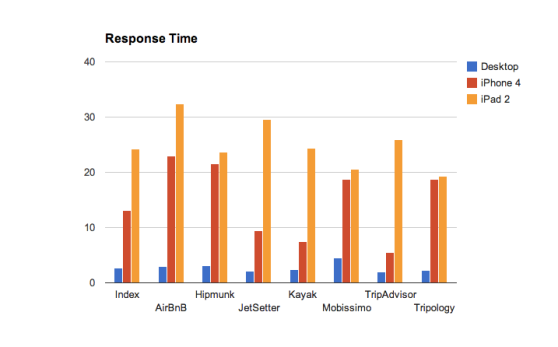 Editor’s note: Keynote Systems’ Startup Shootout Index provides some insight into the three-screen challenge now facing anyone with a web presence. We’ll be bringing you a fresh set of data from Keynote every month. Check out previous Startup Shootout results.
Editor’s note: Keynote Systems’ Startup Shootout Index provides some insight into the three-screen challenge now facing anyone with a web presence. We’ll be bringing you a fresh set of data from Keynote every month. Check out previous Startup Shootout results.
Welcome back and Happy 2013. May it be a successful one for all our startup entrepreneurs.
We track over 40 sites in our Startup Shootout Monthly Index – collaboration sites, travel,
mobile and social gaming, social retail, social networking and digital entertainment – so we see
performance across startups in a variety of industry verticals. As we get to grips with January
and think of plans for the year ahead, we know this is a peak time for travel reservations. Cruise
anyone? Planning that family trip for Spring break? Let’s take a look at our travel category this
month and see how the companies we track are performing.
We focus on tracking startups, so the big names like Travelocity and Priceline aren’t part of
the mix. The index includes some sites that are designed to enhance the travel experience through
reviews or online community forums, as well as online travel agencies that let customers
search for online bookings of airfare, hotels, and rental cars. Two startups aiming to get your
travel dollars are JetSetter and Kayak. These sites compete against the big names in the
industry, but just as importantly, they compete against each other for customers willing to
try a new OTA site.
Optimizing the Online Travel Agency Experience
Interestingly, neither JetSetter nor Kayak is optimized for the tablet experience. Using these
sites on a device like the Apple iPad, customers will see the same web site as they get on a
desktop computer system. On the other hand, both JetSetter and Kayak provide a mobile-
optimized site specifically for smartphone users. Many of the travel sites in the Startup
Shootout Index do not have mobile-optimized sites designed to meet the screen challenges and
network limitations encountered by users of smartphones. So, right off the bat, these two sites
stand out.
JetSetter performs slightly better than Kayak on the desktop environment while Kayak does
better on mobile smartphone devices such as the Apple iPhone 5. Though JetSetter is slower
than Kayak by only a few seconds, this equals a 27% slower experience for their customers on
smartphones. What can we learn from these two sites? Why is one faster than the other?
Kayak has far fewer new HTTP requests – about 14 compared to the 33 on JetSetter. Because
mobile 3G networks have high latency, each HTTP request can introduce delay to the user
perception of the page load. Keynote recommends that companies focused on mobile-
optimized sites should aim for page designs with 10 or fewer new HTTP requests. Kayak has
optimized its site to use CSS sprites, for example, loading multiple small icons in a single
image instead of loading several small image files. Keeping the element count low is a great
competitive advantage for Kayak on mobile.
In addition to fewer new HTTP requests, the Kayak mobile home page also has many fewer
bytes of data on the page. Both JetSetter and Kayak have more than 100 KBytes of page
content, but the JetSetter site exceeds 800 Kbytes. JetSetter also has a very heavy single
JavaScript file – one file that is over 120 Kbytes. It is typically taking three to five seconds to load
this one file. Here at Keynote we recommend 50 Kbytes to 100 Kbytes (or less) to avoid latency
issues.
Besides being slow, this one file creates another major performance problem on the page.
Mobile browsers can “block” when loading JavaScript files. In order to make sure that scripts
files load in a predictable order, browsers often stop loading anything else in parallel while a
script file is loading. Properly implemented, JavaScript does not need to block during downloads.
It can be set up to allow simultaneous downloads. Unlike JetSetter, the JavaScript on the Kayak
site is not blocking. This is one of the big reasons for the 27% speed Kayak has on smartphones
over JetSetter.
On the tablet, these two online travel agency sites are performing very slowly. Over 3G mobile
network connections, Kayak takes just over 24 seconds on average to load. JetSetter takes
just under 30 seconds, making it approximately 21% slower on tablet than Kayak. Neither site
is making a real effort to improve the user experience for tablet visitors on mobile network
connections (or other slower network connections).
Conclusion
Overall, we’re surprised by how many startups we track – especially in a category like
travel – are not yet offering smartphone-optimized sites. We realize this development isn’t
cheap, but for startups trying to capture the interest of consumers willing to try something
new, the smartphone browser is a place where your site can stand out. In this respect, Kayak
and JetSetter set themselves apart from their startup competition with sites optimized for the
smartphone browser. But as we look more closely, Kayak’s site better adheres to Keynote’s best
practices for page weight, element count, and Javascript implementation. Once again, it just
goes to show the potential room for improvement when delivering sites across desktop, tablet
and smartphone environments.
Ken Harker is the mobile evangelist at Keynote Systems.
VentureBeat's mission is to be a digital town square for technical decision-makers to gain knowledge about transformative enterprise technology and transact. Learn More

